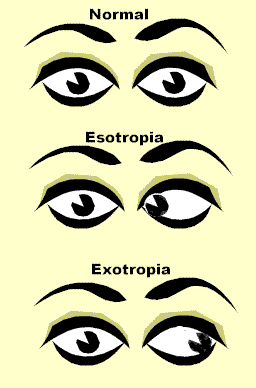![]()
![]()
Causes and Types of Squint
Causes of squint -
Types of squint -The squint may be manifest, called 'tropia' or latent, called 'phoria'. Esotropia - one eye is turned inwards. Commonly called, Crossed Eye. Exotropia -one eye is turned outwards. Commonly called, Wall Eye. Hypotropia - one eye is directed downwards. Hypertropia -one eye is directed upwards. The squint may be intermittently present or may be constant. A squint can become more obvious at the end of the day, when the eyes are tired. |
Convergence Excess : When we look at near objects, our eyes move inwards or "Converge". In some people, this inward movement is more than normal. Then it is called as "Convergence Excess". So these people seem to be "cross eyed", when looking at near objects. But their eyes look normal otherwise. Convergence Insufficiency : In this type of Squint, the inward movement of eyes, while looking at near objects is less than normal. They seem to have "Wall Eye".
|
